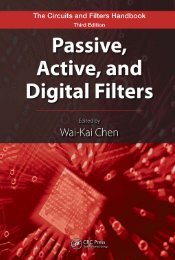An Introduction to the Invertebrates, Second Edition - tiera.ru
An Introduction to the Invertebrates, Second Edition - tiera.ru
An Introduction to the Invertebrates, Second Edition - tiera.ru
You also want an ePaper? Increase the reach of your titles
YUMPU automatically turns print PDFs into web optimized ePapers that Google loves.
PrefaceThis book is an introduc<strong>to</strong>ry guide <strong>to</strong> invertebrate evolution fo<strong>ru</strong>niversity students and o<strong>the</strong>rs. It is designed <strong>to</strong> be read as a whole<strong>to</strong> interest and orientate students who encounter invertebrates.The book is needed because in our overcrowded biology coursessadly little is taught about invertebrates; again and again in recentyears students have asked me ‘Is <strong>the</strong>re a little book?’ because <strong>the</strong>current comprehensive invertebrate textbooks are <strong>to</strong>o big and heavyfor <strong>the</strong>ir requirements.This second edition is needed because in <strong>the</strong> last six years<strong>the</strong>re has been a surge of information from molecular methodsof tracing phylogeny. Knowledge of genes and genetic control ofdevelopment has given us exciting new <strong>to</strong>ols for assessing relationshipsbetween phyla, and new fossil finds have contributed also.The result is that <strong>the</strong>re is an increased interest in invertebrates.Yet <strong>the</strong> relationships between animals can mean nothing withoutsome basic knowledge of <strong>the</strong> animals <strong>the</strong>mselves: an introduc<strong>to</strong>ryguide <strong>to</strong> invertebrates is more than ever necessary. Accordingly,this book maintains <strong>the</strong> st<strong>ru</strong>cture of <strong>the</strong> first edition, with a chapterdevoted <strong>to</strong> each phylum <strong>to</strong> establish how <strong>the</strong> animals with thisparticular body plan can make a living and what forms havebeen able <strong>to</strong> evolve, with a brief paragraph at <strong>the</strong> end indicatingrelationships. The final chapter (20) explains and discusses ourpresent understanding of invertebrate relationships.Changes within <strong>the</strong> earlier chapters, apart from some rearrangementand introducing new discoveries, concern separation of groupswhich have become better unders<strong>to</strong>od: in particular Chapter 6separates acoelomorphs from platyhelminths and Chapter 18 finallyseparates hemichordates from chordates. A box about <strong>the</strong> significanceof body cavities has been removed as being out of date; <strong>the</strong>reis a new box about deep-sea invertebrates.As before, <strong>the</strong> first two chapters of <strong>the</strong> book explain <strong>the</strong> processof evolution by natural selection and indicate how <strong>the</strong> pattern ofevolution may be investigated by molecular as well as morphologicalmethods. Each phylum is <strong>the</strong>n considered in turn, since each consistsof animals with a common body plan that will offer particularopportunities for evolution and impose particular constraints.After <strong>the</strong> body plan of each phylum has been defined, <strong>the</strong> ways oflife open <strong>to</strong> animals so const<strong>ru</strong>cted are considered and <strong>the</strong> resultingdiversity is indicated: this book <strong>the</strong>refore complements booksdiscussing <strong>the</strong> animals living in a particular environment. Eachchapter has a <strong>the</strong>me, indicated at <strong>the</strong> beginning of <strong>the</strong> chapter,relevant <strong>to</strong> <strong>the</strong> particular phylum. Boxes within <strong>the</strong> chapters presentgeneral background information about animal physiology, <strong>the</strong>rebyavoiding inter<strong>ru</strong>ption or repetition. The last two chapters, like <strong>the</strong>











